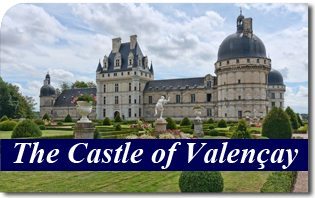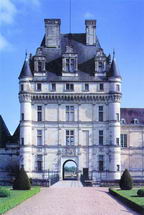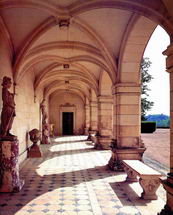 Lordship, Power, Grandeur and Splendor
Lordship, Power, Grandeur and Splendor
The first impression of this castle, located in the Loire Valley, France, is one of enchantment. How marvelous! It is a collection of towers that rise gallantly in the air indicating lordship, power, grandeur and splendor.
These are towers of a fortress-castle. The lack of windows shows the intention to make it a fortification. There are some windows opened on one side, but there are generally no windows overall. Some parts of this building must lack air and light. However, this was needed to prevent the place from being broken into and damaged by enemies. They are towers of a fortress.
There are still crenellations of a medieval tower below the hat-shaped rounded roof and the chimneys on the other wing of the building (pictured atop the page). Everything made using square or sharp angles more readily evokes a military idea of combat than rounded forms. Thus the hat-like roof placed on top of the tower at right gives the castle a civilian air…
In addition to the enchantment mentioned earlier, what are other aspects of our first impression of the castle?
Our subconsciousness is impregnated with the horrors and smirks of modern architecture. When an architectural work like this rises up before our eyes, the main idea that goes through the mind is one of contrast.  On the one hand, one sees the ordinary “unadorned proletarian” aspect in so many contemporary buildings; and on the other hand, ornate buildings like this one, display beauty and nobility. This architectural style clashes with modern building complexes.
On the one hand, one sees the ordinary “unadorned proletarian” aspect in so many contemporary buildings; and on the other hand, ornate buildings like this one, display beauty and nobility. This architectural style clashes with modern building complexes.
The park around the castle is especially beautiful. It consists of large plots of grass and shrubs, making for a certain reverential distinction between the person looking to the castle and the castle itself. The park maintains the distance. All that which is respectable, attracts yet maintains a distance. This is proper to respectability. Our Lord Jesus Christ is the infinite and perfect model of this. Looking at the real statues of the Divine Redeemer, our soul feels a tendency to fly to His heart and … kneel; for all things reputable and elevated attract but maintain a notion of hierarchy.
The castle of Valençay attracts. Is it not true that it also instills respect?
* * *
We ask: Is it not true that it would do countless people a lot of good, if instead of having to stare at today’s bland and cold city hall buildings, they could admire edifices like this?

Another bold question. Who is more cultured: Is it an illiterate peasant who frequently visits the castle and learns how to admire, love and respect it? Or is it someone else living like many others in the countryside who learn how to read, write, do the four arithmetic operations and pick up a smattering of geography but are in touch only with the municipal government, the police station, and the income tax center?
Is it not true that an illiterate person who knows how to appreciate this building understands things better than a literate one who does not know how to appreciate it?
So, we must recognize that there is another form of illiteracy. It is not the one whereby one does not know how to read and write, but it is a kind of illiteracy of the soul whereby one is unable to sense the beauties and wonders of art, culture and civilization.
The preceding article is taken from an informal lecture Professor Plinio Corrêa de Oliveira gave on August 2, 1989. It has been translated and adapted for publication without his revision. –Ed.

